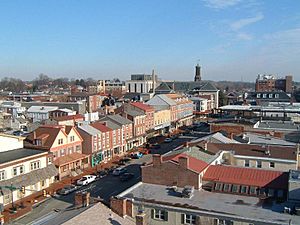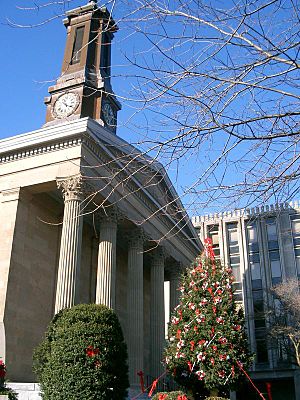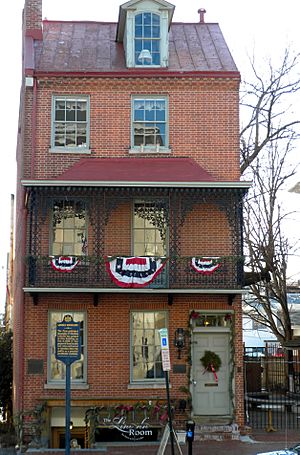History of West Chester, Pennsylvania facts for kids
The exciting history of West Chester, Pennsylvania started way back in 1762. That's when Phineas Eachus and Chest Weaterson got permission to build a tavern. West Chester officially became a borough (a type of town) in 1799.
This town played a big role in American history! One of the country's first railroads was built here in 1832. A famous courthouse, designed by Thomas U. Walter, was finished in 1847. Did you know the very first book about Abraham Lincoln's life was published right here in West Chester?
Around the year 1900, West Chester became a major industrial town, thanks to places like the Sharples Separator Works. During World War II, West Chester even produced more life-saving penicillin than any other place in the United States!
Contents
- West Chester's Beginnings: The 1700s
- West Chester in the 1800s
- Connecting with Railroads
- Famous Buildings and Architecture
- Growing Businesses
- A Famous Artist's Childhood Home
- The Fight Against Slavery
- Lincoln's First Biography
- West Chester During the Civil War
- The Start of West Chester University
- Hoopes Brothers & Darlington: Wheel Makers
- Maple Avenue Nurseries
- Sharples Separator Works: A Major Industry
- Frederick Douglass's Last Speech
- West Chester in the 1900s
- West Chester in the 2000s
West Chester's Beginnings: The 1700s
Native American groups used to camp in the area that is now West Chester. We know this because eight old campsites have been found there. In 1701, a ship captain named Nathaniel Puckle received a large piece of land from William Penn. This land included parts of today's West Chester. The Haines family also bought land here soon after.
By 1760, there were four farms where two important roads crossed. One road went from Pottstown to Wilmington (now High Street). The other went from Philadelphia to the Brandywine Creek (now Gay Street).
The Turk's Head Inn and a New Town
In 1762, Phineas Eachus was allowed to build a tavern. It didn't have a name until 1768, when John Clark bought it and called it the Turk's Head Inn. A small village grew up around this tavern, also called Turk's Head.
On September 11, 1777, the famous Battle of Brandywine happened just a few miles from Turk's Head village. A schoolhouse, located where High and Gay Streets are today, was used as a hospital for injured Colonial soldiers. A small fight between British and Colonial troops also took place nearby after the main battle.
Becoming the County Seat
In 1784, the Pennsylvania General Assembly decided that Chester County needed a new courthouse and prison. They chose Turk's Head as the location. Work on the new courthouse started in the summer of 1784.
Not everyone was happy about this. A man named John Harper, from Chester, Pennsylvania, led a group of people who wanted to destroy the unfinished courthouse. They brought a cannon, muskets, and whiskey, ready to fight! But a group led by John Hannum stopped them.
On November 28, 1786, Turk's Head officially became the center of justice for Chester County. A post office was set up in 1791.
West Chester is Born
John Hannum renamed Turk's Head to West Chester. He started selling land along Gay Street. By 1795, he had planned out the first streets: Church, High, Gay, Market, Chestnut, and Walnut.
On March 28, 1799, West Chester officially became a borough. This happened through a special law passed by the state. Now, elected leaders called "burgesses" would manage the town. William Sharpless was the first burgess elected. The West Chester Fire Company was also started that year. By the year 1800, West Chester had 374 people living there.
West Chester in the 1800s
In 1802, a small marketplace was created, but it wasn't used much. In 1809, Dr. William Darlington created the town's first paved sidewalk. However, sidewalks didn't become common for several more years.
The West Chester Academy, which later became West Chester University, was founded in 1813. Many important people from Chester County studied there. A boarding school for girls opened sixteen years later. To help local farmers, the Agricultural Society of Chester County was started in 1820. William Darlington also created a natural history society in 1826.
Around 1829, William Everhart began selling parts of his land, and new streets were opened. People also started planting shade trees on the streets to make the town look nicer. By 1830, West Chester had 1,244 residents.
Connecting with Railroads
Before 1832, the only way to get to Philadelphia was by wagon. This made it hard for local farmers to sell their produce. The West Chester Railroad tracks were finished in September 1832. Horses pulled wagons on this railroad to Malvern and then on to Philadelphia.
A trip on the railroad took about three hours, much faster than an all-day wagon journey. This helped farmers sell fresh goods. A second railroad to Media was completed in 1858.
Famous Buildings and Architecture
As West Chester grew, a famous architect named Thomas U. Walter was hired to design several important buildings. He even designed parts of the United States Capitol building!
Walter designed the Chester County Courthouse, Horticultural Hall (now the Chester County History Center), the Bank of Chester County, and several churches. The Bank of Chester County was finished in 1837. Work on the new courthouse began in 1846 because the old one was too small. This beautiful Greek Revival style building was completed in 1847. It cost over $55,000 to build.
Growing Businesses
In 1853, Josiah Hoopes started selling plants from his family farm north of West Chester. He began selling fruit trees a few years later. In 1855, he named his business the Cherry Hill Nursery. In 1857, he partnered with his brother Abner to open a shop in town. This business grew steadily and became one of the largest in West Chester.
By 1857, West Chester had many businesses. There were three harness shops, nine blacksmiths, nine wheelwrights, six coopers (barrel makers), and two dozen grocery stores.
A Famous Artist's Childhood Home
The only American-born Impressionist painter, Mary Cassatt, lived in West Chester for a year in 1855. Her family rented a three-story house that is still standing today at High and Miner Streets. Cassatt was friends with famous artists like Renoir, Monet, and Pissarro. Her paintings are now in major museums around the world.
The Fight Against Slavery
Many people in West Chester strongly opposed slavery before the Civil War. Several prominent citizens had homes that were "stations" on the Underground Railroad. This secret network helped enslaved people escape to freedom in Canada.
Famous abolitionists, like William Lloyd Garrison, Wendell Phillips, and Lucretia Mott, gave speeches in West Chester. However, not everyone in town agreed on these views.
Lincoln's First Biography
In 1858, Jesse W. Fell, who was from Chester County, asked Abraham Lincoln to write about his own life. Lincoln first said no, but then wrote a short account of 606 words. He said, "there is not much of it, for the reason, I suppose, that there is not much of me."
Fell sent this story to his friend Joseph J. Lewis in West Chester. Lewis added more details and published the biography in the Chester County Times on February 11, 1860. This was the first published biography of Lincoln. It was shared in newspapers across the U.S. and helped Lincoln get the Republican nomination for president. The building where it was written is now called the Lincoln Building.
West Chester During the Civil War
When the American Civil War began, a training camp was set up in West Chester. The Union army recruited many soldiers from the area. This camp was named Camp Wayne in 1861, after Revolutionary War general Anthony Wayne. It was located at Church Street and Rosedale Avenue.
The Ninth Regiment, with three companies from Chester County, arrived at the camp on May 4, 1861. The 97th regiment was also formed here by local businessman Henry Ruhl Guss. One hundred forty-three of its 950 men were from West Chester. Camp Wayne was eventually taken down in 1862.
A second camp, named Camp Elder, was formed in West Chester in 1863. It was a place for recruiting Black soldiers. After the Battle of Gettysburg, it became a parole camp. About 2,000 Union soldiers were sent there to work on farms for three months while waiting to be exchanged.
The Start of West Chester University
On April 29, 1869, people met to discuss the future of the West Chester Academy. At a second meeting in August, they decided to turn the academy into a normal school. A normal school was a place to train teachers.
The Pennsylvania General Assembly passed a law in 1870 to create the normal school. On September 14, the first stone of the main building was laid. The school opened on September 25, 1871, with 130 students.
Hoopes Brothers & Darlington: Wheel Makers
In 1867, William and Thomas Hoopes (distant cousins of Josiah and Abner) moved to West Chester. They started a business making spokes for wheels. They bought a site on Market Street and opened in September 1867. They weren't immediately successful.
They invited their relative Edward S. Darlington to join the company. In 1869, they began making complete sets of wheels. By 1872, about a hundred men worked for the company, cutting and shaping wood. Their products were even sent to Europe and the Pacific Coast!
The company faced challenges during the panic of 1873. They even threatened to move their factory. But the Hoopes Brothers & Darlington stayed in West Chester, and their business recovered by 1880. In 1894, the company started making wooden bicycle wheels.
Maple Avenue Nurseries
Meanwhile, the Cherry Hill Nursery, owned by Josiah and Abner Hoopes, was doing very well. After the Civil War, the company employed over a hundred people. Their office building, completed in 1880, was designed by a Philadelphia architect. It was decorated with flower gardens and became a beautiful spot in the borough.
By 1881, the brothers owned and farmed 300 acres around West Chester. They also had several greenhouses in town. In 1885, the Hoopes brothers changed the company name to the Maple Avenue Nurseries. By 1898, West Chester was the largest producer of peach trees in the United States, thanks to Maple Avenue.
Josiah Hoopes also designed benches and fountains for Marshall Square Park. He served on the Board of Trustees at the West Chester State Normal School.
Sharples Separator Works: A Major Industry
The third big industry in West Chester in the late 1800s was the Sharples Separator Works. Philip M. Sharples opened a shop in April 1881. He built many items from wood or metal, including farm machinery and steam engines.
In 1883, he started making cream separators, which became his most successful product. In 1889, he moved to a new factory on Maple Avenue. This factory eventually employed 600 workers and produced 3,700 cream separators each year.
Sharples added new ideas like electric lighting and fire alarms. These innovations helped turn West Chester into a major industrial center. By the year 1900, West Chester's population had grown to 9,524 people. It was the largest town in Chester County.
Frederick Douglass's Last Speech
Civil rights leader Frederick Douglass often visited the West Chester area. He frequently stayed at the Magnolia House, an inn owned by Moses Hepburn. Moses Hepburn became West Chester's first African American borough councilor in 1882.
On February 1, 1895, Douglass gave a public speech at the West Chester Normal School. The speech was called "Against Lynch Law." This was his last public appearance, as he passed away on February 20.
West Chester in the 1900s
In 1903, the Hoopes Brothers and Darlington company became a corporation and sold shares to the public. By 1907, they were the third largest wheel manufacturer in the world. After the Model T Ford was introduced and the road to Philadelphia (now West Chester Pike) was paved in 1906, cars became very popular. In June 1909, the Hoopes Brothers and Darlington announced they would start making automobile wheels.
A Famous Composer's Childhood
The famous composer Samuel Barber was born in West Chester on March 9, 1910. West Chester had many beautiful, large homes from its earlier wealthy days. Samuel was the only son of Daisy and Dr. Roy Barber, who were well-known in West Chester.
Samuel Barber started composing songs at age six and was recognized as a musical genius. He began performing piano recitals at West Chester's First Presbyterian Church in 1920. He played music by Bach, Tchaikovsky, and Beethoven, as well as his own songs. He later entered the Curtis Institute in 1924.
A Civil Rights Leader's Early Life
A very important civil rights leader and organizer of the March on Washington, Bayard Rustin, was born in West Chester on March 17, 1912. He never knew his father. His 15-year-old mother, Florence, gave him to her parents, Janifer and Julia Rustin, to raise. Bayard Rustin always considered Janifer and Julia Rustin to be his parents.
In the 1910s, West Chester was a segregated town. This meant that some public places, like theaters, were only open to African Americans at certain times. Other places, like restaurants and downtown stores, were not open to African Americans at all. However, historians note that West Chester was "more benign than most places" when it came to racism.
Rustin grew up in the mostly African-American east end of town. Here, Leslie Pinckney Hill founded a community center in 1918 (now the Charles A. Melton Arts and Education Center). After graduating from West Chester High School in 1932, Rustin went to Wilberforce College.
The Sharples Separator Works Closes
The Sharples Separator Works started having problems in the 1920s. Philip M. Sharples resigned in 1925 after many workers were laid off. His son, Philip T. Sharples, took over. In 1926, they stopped making milk machines. The company tried to survive by building refrigerators and electric generators.
With the 1929 stock market crash, the company faced more difficulties. Due to the Great Depression, the Sharples Separator Works went out of business on March 29, 1933. The company's large building, which cost over $100,000 to build, was sold for only $30,000.
West Chester's Role in World War II
During World War II, West Chester became a key center for producing penicillin. G. Raymond Rettew, a chemist born in West Chester, became known in the 1930s for growing mushrooms. After the Pearl Harbor attacks, Rettew focused on penicillin as a medicine. He built a laboratory in a converted auto garage in West Chester. Before his work, penicillin was mostly just a laboratory curiosity.
Working with Wyeth Pharmaceuticals, Rettew built a new building with refrigerators and a large tank to help make penicillin in huge amounts. Rettew sent his first batch to the government in June 1943. Over 90 percent of it went to the military. By November 1943, Rettew was producing 32,000 cultures every day!
Throughout the war, Rettew's laboratory produced more penicillin than anywhere else in the world. It is estimated that his work saved 100,000 American lives. On May 7, 1944, a military plane crashed at Oaklands Cemetery outside West Chester, killing seven people.
Desegregation and University Growth
West Chester elementary schools were desegregated (meaning Black and white students could attend together) in 1948. This happened thanks to the efforts of Charles and Unise Porter, whose son Gregory was an African-American first-grader.
The West Chester Normal School became West Chester State Teachers College in 1926. It changed its name again to West Chester State College in 1960. In 1983, the institution became West Chester University of Pennsylvania.
West Chester in the 2000s
On October 2, 2013, West Chester University unveiled a bronze statue honoring Frederick Douglass. He had delivered his last public speech on the university's campus less than three weeks before he died. The sculpture was designed by art professor Richard Blake.
University president Greg Weisenstein said, "This is a very important moment in the history of West Chester University. We as a campus community are dedicated to Frederick Douglass' message of freedom and inclusiveness. The statue in the plaza will always serve as a reminder of our steadfast commitment to inclusion and equity for all of the members of our campus community."







